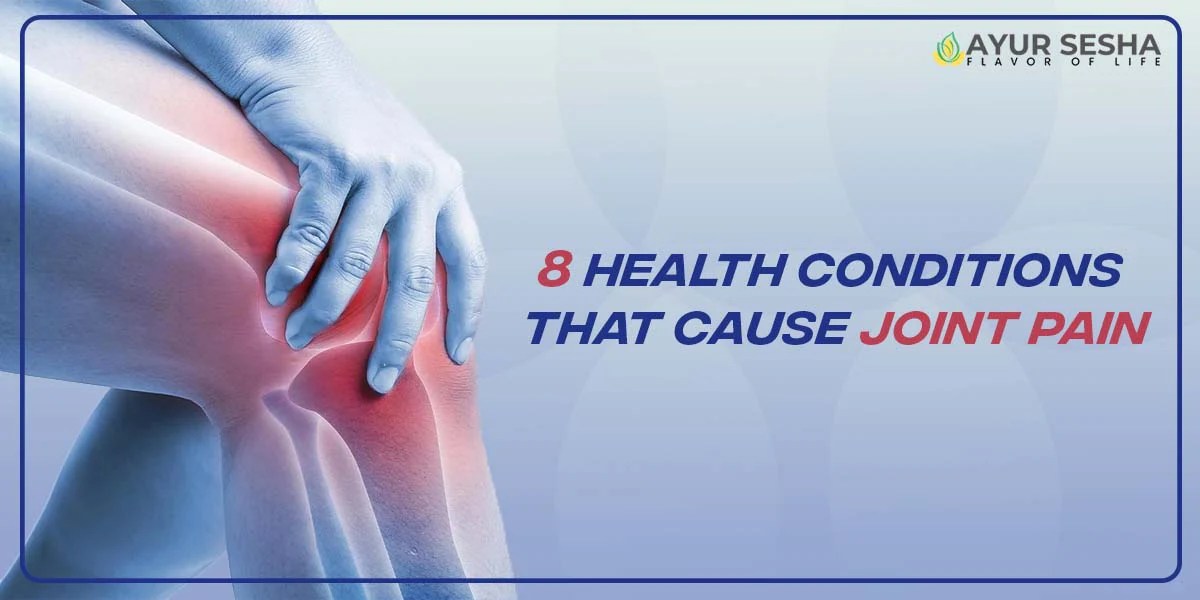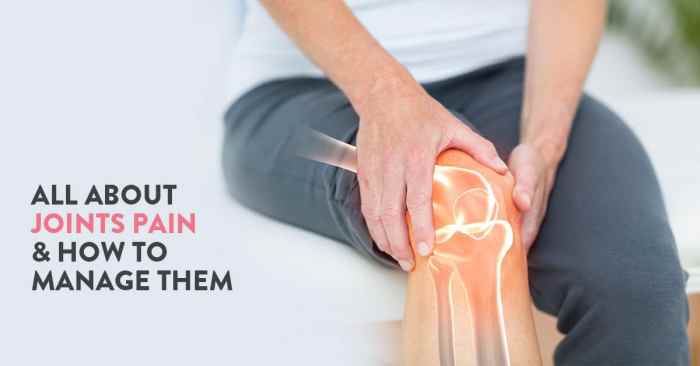Joint pain, a pervasive ailment affecting millions, significantly impacts daily life. Understanding its root causes is crucial for effective management. This exploration delves into eight prevalent sources of joint discomfort, outlining their distinct symptoms, diagnostic methods, and available treatments. We’ll unravel the complexities of conditions like osteoarthritis and rheumatoid arthritis, guiding you through a clearer understanding of this widespread health concern.
From the initial physical examination to advanced imaging techniques like X-rays and MRIs, we’ll navigate the diagnostic journey. We’ll also explore the role of blood tests and discuss self-care strategies, pharmacological interventions, and non-pharmacological approaches such as physical and occupational therapy. Our aim is to empower you with knowledge to effectively address and manage your joint pain.
Common Causes of Joint Pain

Joint pain, a prevalent health concern, significantly impacts quality of life. Understanding its diverse causes is crucial for effective diagnosis and management. This section explores eight common underlying mechanisms leading to joint pain, comparing their symptoms and associated conditions to aid in differentiating them.
Osteoarthritis
Osteoarthritis (OA) is a degenerative joint disease characterized by the breakdown of cartilage, the cushioning tissue between bones. This breakdown leads to bone-on-bone friction, causing pain, stiffness, and reduced joint mobility. Symptoms often develop gradually, starting with mild discomfort that worsens over time. OA most commonly affects weight-bearing joints like the knees, hips, and spine. Advanced cases can result in significant deformity and disability.
Rheumatoid Arthritis
Rheumatoid arthritis (RA) is an autoimmune disease where the body’s immune system mistakenly attacks the synovium, the lining of the joints. This inflammation causes pain, swelling, stiffness, and limited range of motion. Unlike OA, RA often affects smaller joints symmetrically (e.g., both hands and feet). It can also lead to systemic symptoms such as fatigue, fever, and weight loss. RA can cause significant joint damage if left untreated.
Gout
Gout is a form of inflammatory arthritis caused by a buildup of uric acid crystals in the joints. This leads to sudden, severe attacks of pain, redness, swelling, and warmth, often affecting the big toe. Gout attacks can last for several days to weeks and may be accompanied by fever and chills. Untreated gout can lead to chronic joint damage and kidney stones.
Septic Arthritis
Septic arthritis is a joint infection caused by bacteria, viruses, or fungi. It causes rapid onset of severe pain, swelling, redness, warmth, and limited range of motion in the affected joint. The affected joint is often extremely tender to the touch. Septic arthritis is a medical emergency requiring prompt treatment with antibiotics or antiviral medications to prevent permanent joint damage.
Bursitis
Bursitis is inflammation of the bursae, fluid-filled sacs that cushion joints. It causes pain, swelling, and tenderness over the affected bursa. The pain is often worse with movement or pressure on the joint. Common sites for bursitis include the shoulder, hip, elbow, and knee. Treatment usually involves rest, ice, and anti-inflammatory medications.
Tendinitis
Tendinitis is inflammation of a tendon, a fibrous cord that connects muscle to bone. It causes pain, tenderness, and stiffness in the affected area. The pain is often worse with movement or stretching of the tendon. Common sites for tendinitis include the shoulder, elbow, wrist, and knee. Treatment often involves rest, ice, physical therapy, and anti-inflammatory medications.
Fibromyalgia
Fibromyalgia is a chronic condition characterized by widespread musculoskeletal pain, fatigue, sleep disturbances, and cognitive difficulties. The pain is often described as a deep, aching, or burning sensation. It can affect various parts of the body and is often accompanied by tenderness to the touch in specific areas. The exact cause of fibromyalgia is unknown, but it’s thought to involve abnormalities in the central nervous system’s processing of pain signals.
Psoriatic Arthritis
Psoriatic arthritis (PsA) is an inflammatory arthritis associated with psoriasis, a skin condition. It causes pain, swelling, stiffness, and limited range of motion in the affected joints. PsA can affect various joints, including the fingers, toes, and spine. It can also cause inflammation of the tendons and ligaments. The symptoms of PsA can vary widely, and some individuals may only experience mild joint pain.
| Cause | Symptoms | Affected Joints | Associated Conditions |
|---|---|---|---|
| Osteoarthritis | Gradual onset of pain, stiffness, reduced mobility | Weight-bearing joints (knees, hips, spine) | None, primarily degenerative |
| Rheumatoid Arthritis | Pain, swelling, stiffness, symmetrical joint involvement, fatigue, fever | Small joints (hands, feet), often symmetrical | Systemic symptoms, potential for significant joint damage |
| Gout | Sudden, severe pain, redness, swelling, warmth (often in big toe) | Often the big toe, but can affect other joints | Hyperuricemia, kidney stones |
| Septic Arthritis | Rapid onset of severe pain, swelling, redness, warmth, limited mobility | Any joint | Infection (bacterial, viral, fungal) |
| Bursitis | Pain, swelling, tenderness over the bursa | Shoulder, hip, elbow, knee | Overuse, injury |
| Tendinitis | Pain, tenderness, stiffness, worse with movement | Shoulder, elbow, wrist, knee | Overuse, injury |
| Fibromyalgia | Widespread musculoskeletal pain, fatigue, sleep disturbances, cognitive difficulties | Multiple areas of the body | Central nervous system dysfunction |
| Psoriatic Arthritis | Pain, swelling, stiffness, limited mobility, skin lesions (psoriasis) | Fingers, toes, spine | Psoriasis |
Diagnostic Methods for Joint Pain

Diagnosing the underlying cause of joint pain requires a multi-faceted approach, combining a thorough medical history, physical examination, and various diagnostic tests. The goal is to pinpoint the specific condition affecting the joint, enabling appropriate and effective treatment. A precise diagnosis is crucial to prevent long-term damage and improve the patient’s quality of life.
Physical Examination
A comprehensive physical examination is the cornerstone of joint pain diagnosis. The physician will assess the affected joint(s), noting swelling, redness, warmth, tenderness, range of motion, and any deformities. They will also evaluate the patient’s gait and posture to identify any compensatory movements resulting from the pain. Palpation of the joint and surrounding tissues helps detect abnormalities such as crepitus (a grating sound or sensation), fluid accumulation, and muscle spasms. Neurological examination may be necessary to rule out nerve involvement. The physician will also inquire about the patient’s medical history, including past injuries, illnesses, and medications. This information provides crucial context for interpreting the physical findings.
Imaging Techniques
Imaging techniques play a crucial role in visualizing the structures within and around the joint, revealing abnormalities not readily apparent during a physical examination.
X-rays
X-rays are readily available, relatively inexpensive, and provide excellent visualization of bone structures. They can identify fractures, dislocations, osteoarthritis (characterized by joint space narrowing and bone spurs), and other bone-related pathologies. However, X-rays have limitations in visualizing soft tissues like cartilage, ligaments, and tendons. For example, an X-ray might show advanced osteoarthritis with significant bone spurs, but might not reveal early-stage cartilage damage.
Magnetic Resonance Imaging (MRI)
MRI offers superior soft tissue contrast compared to X-rays. It provides detailed images of cartilage, ligaments, tendons, muscles, and bone marrow, allowing for the detection of injuries like meniscus tears, ligament sprains, and bone bruises. MRI is particularly useful in diagnosing conditions like rheumatoid arthritis, which involves inflammation of the synovial membrane (the lining of the joint). An example of an MRI finding might be a clear visualization of a torn anterior cruciate ligament (ACL) in the knee. However, MRI is more expensive and time-consuming than X-rays and may not be suitable for all patients (e.g., those with claustrophobia or metallic implants).
Ultrasound
Ultrasound uses high-frequency sound waves to create images of soft tissues. It is a relatively inexpensive and readily available technique that can assess joint inflammation, fluid accumulation, and the integrity of tendons and ligaments. Ultrasound is often used to guide injections into joints, such as corticosteroid injections for pain relief. For instance, an ultrasound might reveal tenosynovitis (inflammation of the tendon sheath) causing pain and restricted movement in the wrist. However, ultrasound images can be operator-dependent, and the quality of the image can be affected by factors such as patient body habitus.
Blood Tests
Blood tests are essential in diagnosing certain types of joint pain, particularly those related to inflammatory or autoimmune conditions.
Types of Blood Tests and Their Significance
Several blood tests can aid in diagnosis. These include tests for inflammatory markers like erythrocyte sedimentation rate (ESR) and C-reactive protein (CRP), which are elevated in inflammatory conditions such as rheumatoid arthritis. Autoantibody tests, such as rheumatoid factor (RF) and anti-citrullinated protein antibodies (ACPA), are used to detect autoimmune diseases like rheumatoid arthritis. Other blood tests may assess for infections, metabolic disorders, or other systemic diseases that can contribute to joint pain. For example, elevated uric acid levels may indicate gout.
Step-by-Step Joint Pain Diagnosis
The diagnostic process typically follows these steps:
- Detailed medical history: Patient’s description of symptoms, duration, location, and aggravating/relieving factors.
- Physical examination: Assessment of joint(s), range of motion, and neurological function.
- Imaging studies (X-rays, MRI, ultrasound): Visualizing the joint structures and detecting abnormalities.
- Blood tests: Assessing for inflammatory markers, autoantibodies, and other relevant indicators.
- Diagnostic injections: In some cases, injections of local anesthetic or corticosteroids into the joint may help confirm the diagnosis.
- Consultation with specialists: Referral to rheumatologists, orthopedists, or other specialists, depending on the suspected diagnosis.
Self-Care and Treatment Options

Managing joint pain effectively often involves a combination of self-care strategies and medical interventions. A proactive approach encompassing lifestyle adjustments and appropriate treatment can significantly improve comfort and functionality. Understanding the various options available allows for a personalized approach tailored to individual needs and the severity of the condition.
Lifestyle Modifications for Joint Pain Management
Maintaining a healthy lifestyle plays a crucial role in managing joint pain. Dietary choices and regular physical activity can significantly impact both pain levels and overall joint health. Weight management is particularly important, as excess weight puts extra stress on joints.
Dietary recommendations often include focusing on anti-inflammatory foods rich in omega-3 fatty acids, such as fatty fish (salmon, tuna), flaxseeds, and walnuts. Fruits and vegetables, abundant in antioxidants, also contribute to overall health and may help reduce inflammation. Conversely, limiting processed foods, sugary drinks, and red meat can help minimize inflammation.
Regular, low-impact exercise is essential. Activities like swimming, cycling, and walking are generally well-tolerated and help maintain joint mobility and muscle strength. It’s crucial to consult a healthcare professional or physical therapist to determine appropriate exercise regimens tailored to individual needs and limitations.
Pharmacological Treatments for Joint Pain
Pharmacological interventions provide relief from pain and inflammation associated with joint conditions. The choice of medication depends on the severity of pain, underlying condition, and individual patient factors. It’s crucial to discuss medication options with a doctor to determine the most suitable approach and to monitor for potential side effects.
| Medication Type | Mechanism of Action | Common Side Effects | Dosage Considerations |
|---|---|---|---|
| Over-the-counter (OTC) Analgesics (e.g., Acetaminophen) | Reduces fever and provides mild pain relief through central nervous system action. Does not reduce inflammation. | Liver damage (with high doses or prolonged use), allergic reactions (rare) | Follow package instructions carefully. Consult a doctor for prolonged use or high doses. |
| Nonsteroidal Anti-inflammatory Drugs (NSAIDs) (e.g., Ibuprofen, Naproxen) | Reduces pain and inflammation by inhibiting the production of prostaglandins. | Gastrointestinal upset (nausea, heartburn, ulcers), kidney problems, increased risk of cardiovascular events (with long-term use). | Follow package instructions. Consult a doctor for prolonged use or high doses. Individuals with pre-existing conditions such as kidney or heart disease should use with caution. |
| Prescription NSAIDs (e.g., Celecoxib) | Similar mechanism to OTC NSAIDs, but with potentially reduced gastrointestinal side effects. | Increased risk of cardiovascular events, fluid retention, allergic reactions. | Dosage determined by a physician based on individual needs and medical history. |
| Corticosteroids (e.g., Prednisone) | Potent anti-inflammatory and immunosuppressant effects. | Weight gain, increased blood sugar, increased risk of infections, bone thinning (with long-term use). | Used for short-term management of severe inflammation under strict medical supervision. |
Non-Pharmacological Treatments for Joint Pain
Physical and occupational therapies play vital roles in managing joint pain by improving mobility, strength, and function. These therapies often involve targeted exercises, manual techniques, and assistive devices.
Physical therapy focuses on improving range of motion, strength, and flexibility through exercises tailored to the specific joint(s) affected. Examples include range-of-motion exercises, strengthening exercises using resistance bands or weights, and low-impact cardiovascular exercises. A physical therapist will guide patients through appropriate exercises and provide personalized instruction.
Occupational therapy focuses on adapting daily activities to minimize strain on affected joints. This may involve modifying workspaces, recommending assistive devices (e.g., adaptive utensils, splints), and teaching energy conservation techniques.
Appropriate Stretches for Common Joint Pain Areas
Visual representation of stretches:
Knee Pain: Imagine a person sitting on the floor with legs extended. They gently pull one leg towards their chest, holding the shin or thigh, feeling a stretch in the hamstring and knee. The other leg remains extended for balance. Repeat on the other side.
Shoulder Pain: Picture a person standing, gently raising one arm overhead and bending the elbow, reaching behind the neck and upper back. The opposite hand gently pulls the elbow closer to the head, stretching the shoulder muscles. Repeat on the other side.
Hip Pain: Visualize a person lying on their back with knees bent and feet flat on the floor. They slowly cross one leg over the other, keeping the shoulders flat on the floor, feeling a stretch in the hip and outer thigh. Repeat on the other side.
Neck Pain: Imagine a person sitting upright. They gently tilt their head to one side, bringing their ear towards their shoulder, feeling a stretch along the side of the neck. Hold, then repeat on the other side. They can also gently rotate their head from side to side, keeping the movements slow and controlled.
Final Conclusion

Successfully navigating joint pain requires a multifaceted approach. By understanding the various causes, employing appropriate diagnostic methods, and utilizing a combination of self-care and medical interventions, individuals can significantly improve their quality of life. Remember that early diagnosis and proactive management are key to minimizing long-term complications and maintaining mobility and well-being. This comprehensive overview serves as a starting point for a more in-depth exploration, prompting further consultation with healthcare professionals for personalized care and treatment plans.